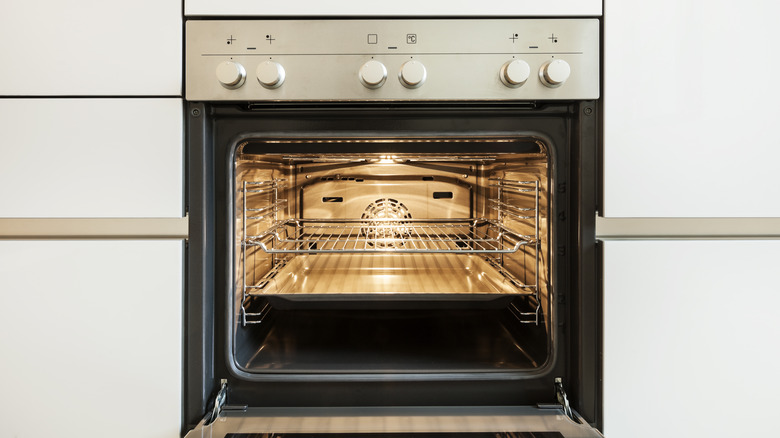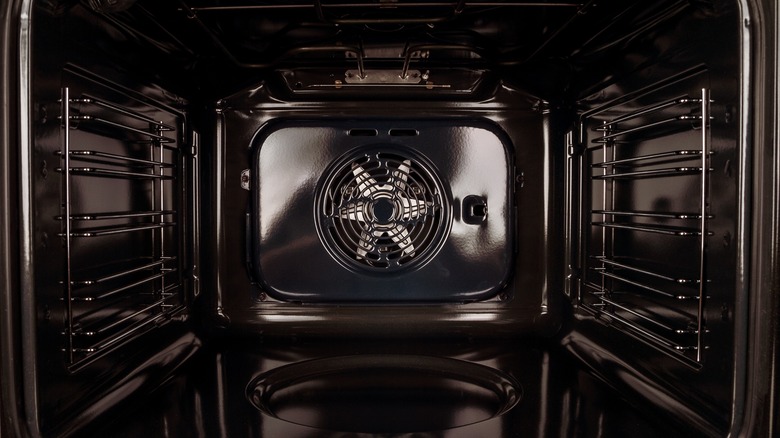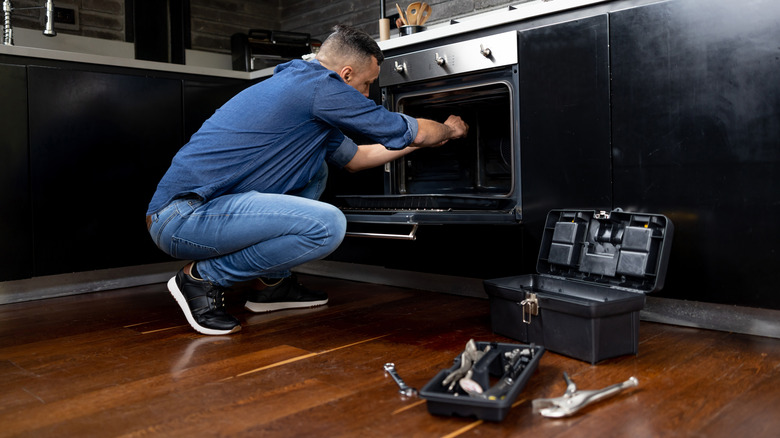If Your Oven Won't Stop Squeaking, You Likely Need To Clean This Feature
There's nothing like hearing a mysterious oven noise in the middle of cooking dinner to make you panic and decide to make a sandwich instead. It's an understandable worry, especially if you own a gas oven — gas safety is a serious matter. But sometimes, these sounds might just require a simple fix. To figure out what's going on, the first step is to pin down the type of noise you're hearing and when. Does it happen during preheating, baking, cooling down, or all three? Is it a squeaking, banging, rattling, or something else? If your answer is "squeaking," you might be relieved to find out that the culprit is probably just one component: the cooling fan. It may need to be cleaned or replaced, especially if the noise continues even after the oven is off.
A noisy oven can also be the result of a different loose, dirty, or damaged component. Some noises can be a sign that it's time to deep clean your oven or that the oven is too old to function properly anymore. Since similar noises can mean different things, it might be hard for you to pin down the exact problem, and oven repair involves many safety risks. That's why it can be helpful to have a professional come take a look. But you may be able to fix your squeaking oven yourself.
How to clean your cooling fan
Your oven's cooling fan is important because it helps cool down the inside of the oven after it's no longer in use (not to be mistaken for the exhaust fan, which is outside of the oven). On a regular oven, the cooling fan typically runs during and after the oven's heating cycle. Convection ovens are a bit different — their fans help the food cook evenly and run during preheating as well.
A bizarre oven noise that continues after the oven is off is one sign that the cooling fan needs to be cleaned. A dirty or damaged fan can also lead to other noises besides squeaking, like grinding or rattling. If you're handy, you can clean and inspect your cooling fan yourself. But since it often requires removing a panel or door to reach the fan or potentially removing it entirely, you may want to call a pro. If you decide to DIY, your oven's manual should include instructions on accessing and cleaning the fan. Make sure the oven is fully empty, unplugged, and cool, then access the fan and get rid of any debris inside. You may have to use a soft brush or cloth to remove dust. After cleaning, give the fan a good lubrication.
When to replace the cooling fan
If you still hear a squeaking noise after you've cleaned and lubricated the oven cooling fan, it may need to be replaced altogether. If the fan is broken, it's also time to get a new one. Signs of damage include burnt pieces or cracked parts. Sometimes, a broken fan won't have any visible damage at all but still doesn't work correctly and must be replaced.
A new cooling fan typically costs between $100 and $200, and replacing it yourself is an option for the handy. Similar to cleaning the fan, replacing it often requires removing a panel or door (or both) in order to access it, and it can be tricky to DIY depending on the oven model and your level of experience. You'll need to unplug and unscrew the old fan, then re-attach all wires to the new fan in their proper place. Consult your owner's manual for guidance, and check your manufacturer's specifications to make sure your new cooling fan is compatible with your oven.
If you're unsure about whether you need a new cooling fan or need help installing a new one, don't hesitate to call in a professional to help. It costs more to hire out instead of DIY but is well worth the peace of mind of knowing that your oven is operating safely.


